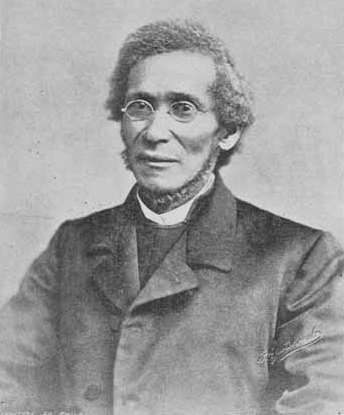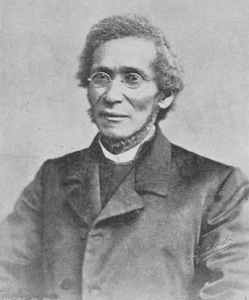
After emancipation, Northern churches founded by free blacks, as well as those of predominantly white denominations, sent missions to the South to minister to newly freed slaves, including to teach them to read and write. For instance, Bishop Daniel Payne of the AME Church returned to Charleston, South Carolina in April 1865 with nine missionaries. He organized committees, associations, and teachers to reach freedmen throughout the countryside. In the first year after the war, the African Methodist Episcopal (AME) Church gained 50,000 congregants.
By the end of Reconstruction, AME congregations existed from Florida to Texas. Their missioners and preachers had brought more than 250,000 new adherents into the church. While it had a northern base, the church was heavily influenced by this growth in the South and incorporation of many members who had different practices and traditions.[18] Similarly, within the first decade, the independent AME Zion church, founded in New York, also gained tens of thousands of Southern members. These two independent black denominations attracted the newest members in the South.
In 1870 in Jackson, Tennessee, with support from white colleagues of the Methodist Episcopal Church, South, more than 40 black Southern ministers, all freedmen and former slaves, met to establish the Southern-based Colored Methodist Episcopal (CME) Church (now Christian Methodist Episcopal Church), founded as an independent branch of Methodism. They took their mostly black congregations with them. They adopted the Methodist Doctrine and elected their first two bishops, William H. Miles of Kentucky and Richard H. Vanderhorst of South Carolina. Within three years, from a base of about 40,000, they had grown to 67,000 members, and more than te times that many in 50 years.
At the same time, black Baptist churches, well-established before the Civil War, continued to grow and add new congregations. With the rapid growth of black Baptist churches in the South, in 1895 church officials organized a new Baptist association, the National Baptist Convention. This was the unification of three national black conventions, organized in 1880 and the 1890s. It brought together the areas of mission, education and overall cooperation. Despite founding of new black conventions in the early and later 20th century, this is still the largest black religious organization in the United States. These churches blended elements from underground churches with elements from freely established black churches.
The postwar years were marked by a separatist impulse as blacks exercised the right to move and gather beyond white supervision or control. They developed black churches, benevolent societies, fraternal orders and fire companies. In some areas, they moved from farms into towns, as in middle Tennessee, or to cities that needed rebuilding, such as Atlanta. Black churches were the focal points of black communities, and their members’ quickly seceding from white churches demonstrated their desire to manage their own affairs independently of white supervision. It also showed the prior strength of the “invisible church” hidden from white eyes.
Black preachers provided leadership, encouraged education and economic growth, and were often the primary link between the black and white communities. The black church established and/or maintained the first black schools and encouraged community members to fund these schools and other public services. For most black leaders, the churches always were connected to political goals of advancing the race. There grew to be a tension between black leaders from the North and people in the South who wanted to run their churches and worship in their own way.
Since the male hierarchy denied them opportunities for ordination, middle-class women in the black church asserted themselves in other ways: they organized missionary societies to address social issues. These societies provided job training and reading education, worked for better living conditions, raised money for African missions, wrote religious periodicals, and promoted Victorian ideals of womanhood, respectability, and racial uplift.
Daniel Alexander Payne (February 24, 1811 – November 2, 1893) was an American bishop, educator, college administrator and author. A major shaper of the African Methodist Episcopal Church (AME), Payne stressed education and preparation of ministers and introduced more order in the church, becoming its sixth bishop and serving for more than four decades (1852–1893) as well as becoming one of the founders of Wilberforce University in Ohio in 1856. In 1863 the AME Church bought the college and chose Payne to lead it; he became the first African-American president of a college in the United States and served in that position until 1877.
By quickly organizing AME missionary support of freedmen in the South after the Civil War, Payne gained 250,000 new members for the AME Church during the Reconstruction era. Based first in Charleston, he and his missionaries founded AME congregations in the South down the East Coast to Florida and west to Texas. In 1891 Payne wrote the first history of the AME Church, a few years after publishing his memoir.
Daniel Payne was born free in Charleston, South Carolina, on February 24, 1811, of African, European and Native American descent. Daniel stated “as far as memory serves me my mother was of light-brown complexion, of middle stature and delicate frame. She told me that her grandmother was of the tribe of Indians known in the early history of the Carolinas as the Catawba Indians.” He also stated that he descended from the Goings family, who were a well known free colored/Native American family. His father was one of six brothers who served in the Revolutionary War and his paternal grandfather was an Englishmen. His parents London and Martha Payne were part of the “Brown Elite” of free blacks in the city. Both died before he reached maturity. While his great-aunt assumed Daniel’s care, the Minors’ Moralist Society assisted his early education. Payne was raised in the Methodist Church like his parents. He also studied at home, teaching himself mathematics, physical science, and classical languages. In 1829, at the age of 18, he opened his first school.
After the Nat Turner Rebellion of 1831, South Carolina and other southern states passed legislation restricting the rights of free people of color and slaves. They enacted a law on April 1, 1835, which made teaching literacy to free people of color and slaves illegal and subject to fines and imprisonment. With the passage of this law, Payne had to close his school.
In May 1835, Payne sailed from Charleston to Philadelphia in search of further education. Declining the Methodists’ offer, which was contingent on his going on a mission to Liberia, established as a colony for free blacks from the United States, Payne studied at the Lutheran Theological Seminary at Gettysburg in Pennsylvania. Payne never worked as a Lutheran priest. One source claims he had to drop out of school because of problems with his eyesight.Another source claimed no congregation called him and the Lutheran Church told him to work through the Methodist Episcopal Church.

